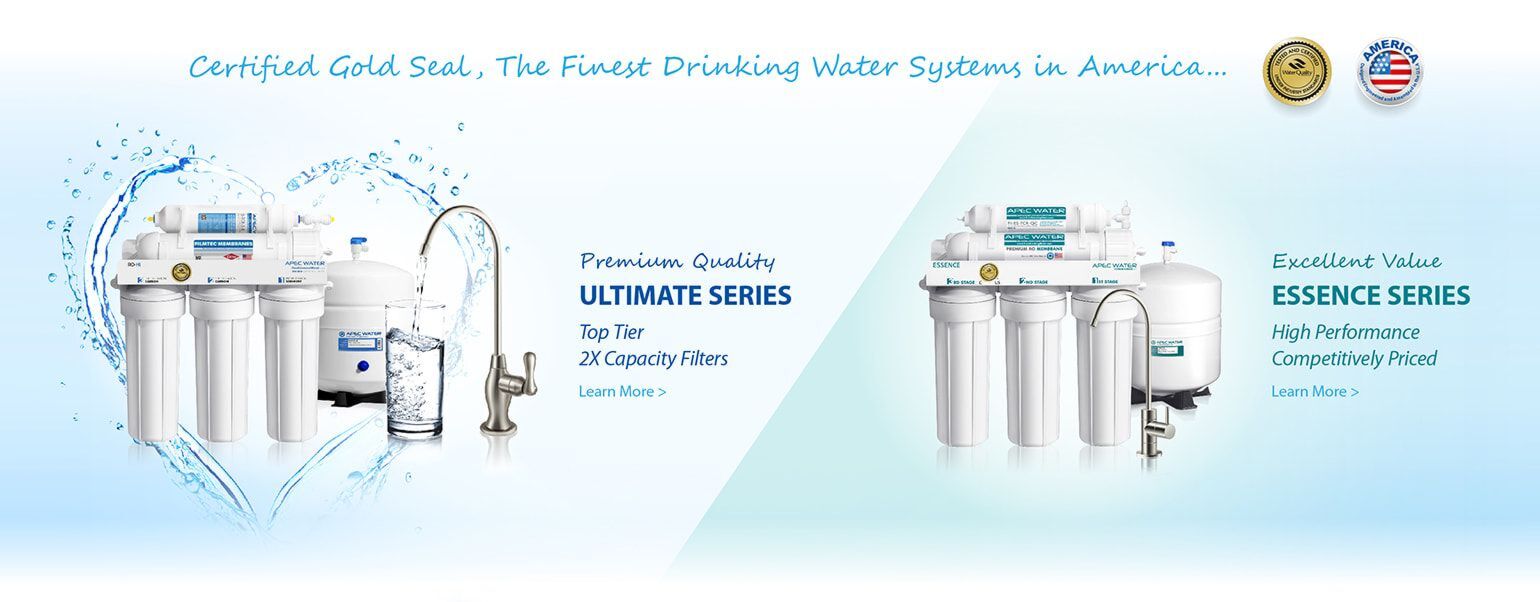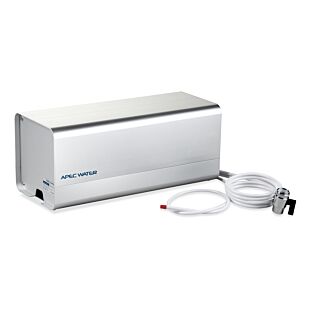Reverse Osmosis
Water Systems
Commercial Reverse
Osmosis Water System
Water Filtration
System
Salt-Free Water
Conditioner
Whole House
Water Filter
Whole House
Solution System
Total Solution
Whole House System
Filters &
Parts
Designer
Faucet
Car Wash
System
Shower & Bath
Filter
Multi Purpose UV
Disinfection System
Instant Hot / Cold
Water System
Food Service
Filtration System
Healthy Water
Bottles & Pitchers
Water Quality
Testing Kits
Water Pressure
Booster
Commercial Filter
Housing
Reverse Osmosis Water Filter Systems

Reverse Osmosis Water Filter Systems
What is a Reverse Osmosis Water System?
Reverse Osmosis Systems are used to filter out impurities in drinking water such as chlorine, salt or sediments, making the water safer to drink, and with better taste. This is done through using pressure to push water through the filter’s semi-permeable membrane to separate those larger particles from the pure water.
- ROTL-AIO - All-in-One Tankless Premium Reverse Osmosis Water SystemsMember Price $339.95 Listed Price $349.95Out of stock
APEC Tankless Reverse Osmosis Water Systems
- All-In-One filter removes 1,000+ contaminants
- Space-saving design
- LED filter life indicator
- Less than 1 minute filter change. No tools needed
- 2:1 drain ratio, save up to 600% of water
- Comes with designer faucet
- Electrical outlet is required to operate the RO system
- ROTL-600 - 3 Stages Premium Reverse Osmosis Water Systems$599.95
APEC Tankless Reverse Osmosis Water Systems
- 3-Stage filters removes 1,000+ contaminants
- Space-saving design
- LED filter life indicator
- Quick and easy filter change. No tools needed
- Convenient front-facing filter change
- Comes with designer faucet
- Electrical outlet is required to operate the RO system
- ROTL-600-PH - 3 Stages Premium pH+ Reverse Osmosis Water Systems$599.95
APEC Tankless Reverse Osmosis Water Systems
- 3-Stage filters removes 1,000+ contaminants
- Space-saving design
- LED filter life indicator
- Quick and easy filter change. No tools needed
- Convenient front-facing filter change
- Comes with designer faucet
- Electrical outlet is required to operate the RO system
- pH+ Alkaline Re-Mineralizing Water
- RO-Hi – Ultimate 5-Stage 90 GPD High Output Fast Flow Reverse Osmosis Water Systems for Drinking Water, WQA CertifiedMember Price $289.95 Listed Price $299.95
Our No. 1 Most Popular System
- Provides refreshing crisp taste superior to bottled water
- High flow 90 GPD production system with super capacity filters
- 3/8" Output Quick Dispense Feature Increases The Flow Rate 2X Faster To Fill Up Your Glass & Pitcher
- Certified with WQA Gold Seal, highest contaminant rejection guaranteed
- System built with US MADE top tier certified premium quality parts
- Comes with premium designer faucet in brushed nickel finish and 4 gallon tank. Options are available
- RO-90 – Ultimate 5-Stage 90 GPD High Output Reverse Osmosis Water Systems for Drinking Water, WQA CertifiedMember Price $219.95 Listed Price $229.95
Our Ultimate WQA Certified System
- Provides refreshing crisp taste superior to bottled water
- High flow 90 GPD production system with super capacity filters
- Certified with WQA Gold Seal, highest contaminant rejection guaranteed
- System built with US MADE top tier certified premium quality parts
- Comes with designer faucet and 4 gallon tank
- RO-PH90 – Ultimate Alkaline Mineral 90 GPD 6-Stage High Output Reverse Osmosis Water Systems for Drinking Water, WQA CertifiedMember Price $339.95 Listed Price $349.95
The Ultimate pH enhancer
- All the feature of RO-90 + calcium mineral for improve alkalinity and great taste
- Systems built with all US Made 6-Stages premium quality filters
- Removes 99% of water contaminants while provide clean drinking mineral water
- Comes with premium designer faucet in brushed nickel finish and 4 gallon tank. Options are available
- RO-PERM – Ultimate Permeate Pumped Reverse Osmosis Water Systems for Drinking Water, for Low Pressure HomesMember Price $369.95 Listed Price $379.95
Low Water Pressure Booster (30 – 50 psi)
- All the feature of RO-90 plus pump for performance upgrade
- Fills tanks faster and fuller w/ increased delivery pressure at faucet
- Guaranteeing highest contaminant rejection
- Comes with premium designer faucet in brushed nickel finish and 4 gallon tank. Other options are available
- RO-PUMP – Electric Pumped Reverse Osmosis Water System for Drinking Water, for International UseMember Price $399.95 Listed Price $411.95
Perform under no water pressure (0 – 30 psi)
- For international homes or low to no water pressure applications
- Durable & quiet booster pump increases input water pressure
- Super capacity filters for low maintenance & high reliability
- System built with US MADE top tier certified premium quality parts
- Comes with premium designer faucet in brushed nickel finish and 4 gallon tank. Other options are available
- RO-TWIST – Supreme 4-Stage 75 GPD Twist Easy Filter Change Undersink Reverse Osmosis Water Systems for Drinking WaterMember Price $229.95 Listed Price $234.95
Quickest Filter Change Ever
- Designed, engineered and assembled in the USA
- Remove up to 99% of contaminants from the source water
- Featured twist-lock design for easy filter change outs
- Compact space saving size suitable for undersink cabinet with limited room
- Less waste water
- Comes with premium designer faucet and 4 gallon tank. Other options are available
- RO-QUICK90 – Ultimate Compact 4-Stage 90 GPD High Output Undersink Reverse Osmosis Water Systems for Drinking WaterMember Price $239.95 Listed Price $249.95
Compact 4-Stage System
- Premium US made filters are effective in removing up to 99% of contaminants
- RO-QUICK90 is equipped with all disposable filters to make filter change out SIMPLE, PAINLESS and SANITARY
- Ultra compact design makes the system fit easily and elegantly into your UNDERSINK cabinet and allows maximum use of the under counter space.
- Comes with a 100% lead-free designer faucet to make your counter top look great
- Comes with designer faucet and 4 gallon tank
- ROCT-PLUS - Portable All-In-One Instant Hot Countertop Reverse Osmosis Water Systems$349.95
Instant Hot 4 Temperature Presets
- No drilling, no plumbing. Simply plug in and start drinking.
- Convenient countertop Reverse Osmosis filtration system.
- Remove chemicals, VOCs, Odor and Color, and 1000+ Contaminants
- 3-second filter change
- 3:1 Pure to drain ratio. More pure water and less waste water.
- RO-CTOP – Portable 90 GPD Countertop Reverse Osmosis Water Systems for Drinking WaterMember Price $229.95 Listed Price $239.95
Mobility and Performance in one small package
- Compatible With Standard Faucets. Will Not Work With pull-out faucet, special size designer faucet and sprayer faucet
- Lightweight installation-free system, hooks up to most standard faucets in minutes
- 4-stage compact system built with high capacity filters, for convenient drinking water anywhere
- Best for apartment or student who still demand the best water purification technology
- RO-CTOP-PH – Portable Alkaline Mineral 90 GPD Countertop Reverse Osmosis Water Systems for Drinking WaterMember Price $249.95 Listed Price $259.95
Portable Alkaline Drinking Water System
- Compatible With Standard Faucets. Will Not Work With pull-out faucet, special size designer faucet and sprayer faucet
- Lightweight installation-free system, hooks up to most standard faucets in minutes
- 4-stage compact system for convenient Alkaline drinking water anywhere
- Best for apartment or student who still demands the best water purification technology
- RO-CTOP-C – Portable 90 GPD Countertop Reverse Osmosis Water Systems for Drinking Water, With CaseMember Price $269.95 Listed Price $279.95
Mobility and Performance in one small package
- Compatible with standard faucets. Will not work with pull-out or built-in sprayer faucets
- Lightweight installation-free system, hooks up to most standard faucets in minutes
- 4-stage compact system built with high capacity filters, for convenient drinking water anywhere
- Best for apartment or student who still demand the best water purification technology
- RO-CTOP-PHC – Portable Alkaline Mineral 90 GPD Countertop Reverse Osmosis Water Systems for Drinking Water, With CaseMember Price $289.95 Listed Price $299.95
Portable Alkaline Drinking Water System
- Compatible With Standard Faucets. Will Not Work With pull-out faucet, special size designer faucet and sprayer faucet
- Lightweight installation-free system, hooks up to most standard faucets in minutes
- 4-stage compact system for convenient Alkaline drinking water anywhere
- Best for apartment or student who still demands the best water purification technology
- ROES-100 - Essence 5-stage 100 GPD Reverse Osmosis Water Systems for Drinking WaterMember Price $229.95 Listed Price $234.95
Quick Dispense Affordable Option
- Systems designed, engineered and assembled in the USA with supreme quality components & filters
- Lowest 1:1 drain ratio reduces waste water up to 300%
- 3/8" Output Quick Dispense feature increases the flow rate 2X faster to fill up your glass & pitcher
- Trusted APEC brand & quality at competitive pricing
- Complete 5 Stage filtration, removes 1,000+ water contaminants
- Comes with designer faucet in brushed nickel finish and 4 gallon tank
- ROES-50 - Essence 5-stage 50 GPD Reverse Osmosis Water System for Drinking Water, WQA CertifiedMember Price $189.95 Listed Price $199.95
Our Affordable Performer
- Systems designed, engineered and assembled in the USA with supreme quality components & filters
- Certified with WQA Gold Seal, highest contaminant rejection guaranteed
- Trusted APEC brand & quality at competitive pricing
- Complete 5 Stage filtration, removes 1,000 + water contaminants
- Comes with designer faucet in brushed nickel finish and 4 gallon tank
- ROES-PH75 - Essence Alkaline Mineral 6-Stage 75 GPD Reverse Osmosis Water Systems for Drinking Water, WQA CertifiedMember Price $229.95 Listed Price $234.95
Pure Water + Alkalinity
- Pure drinking water + calcium minerals for improved alkalinity and great taste
- Systems designed, engineered and assembled in the USA with supreme quality components & food grade calcium from trusted sources
- Certified with WQA Gold Seal, highest contaminant rejection guaranteed
- 6 stage RO removes up to 99% of water contaminants
- Comes with designer faucet in brushed nickel finish and 4 gallon tank
- ROES-PHUV75 - Essence Alkaline Mineral pH+ and UV Ultra-Violet Sterilizer 75 GPD 7-Stage Reverse Osmosis Water Systems for Drinking WaterMember Price $299.95 Listed Price $309.95
7-Stage UV + PH Reverse Osmosis Filtration
- Pure drinking water + calcium minerals for improved alkalinity and great taste
- Removes up to 99% of bacteria, viruses, cysts, organics, chemicals, heavy metals & more
- Systems designed, engineered and assembled in the USA with supreme quality components & food grade calcium from trusted sources
- 7 stage RO removes up to 99% of water contaminants
- Comes with designer faucet in brushed nickel finish and 4 gallon tank
- ROES-UV75 - Essence UV Disinfecting 6-Stage 75 GPD Reverse Osmosis Water Systems for Drinking Water$299.95
Extra Protection with Ultra Violet Light
- 6-Stage UV-RO system perfect for well or un-chlorinated water
- Equipped with 1 GPM US Made UV sanitizer for highest Bacteria removal
- Removes up to 99% of bacteria, viruses, cysts, organics, chemicals, heavy metals & more
- Comes with designer faucet in brushed nickel finish and 4 gallon tank
- ROES-UV75-SS - Essence Stainless Steel UV Disinfecting 6-Stage 75 GPD Reverse Osmosis Water Systems for Drinking WaterMember Price $279.95 Listed Price $289.95
Extra Protection with Ultra Violet Light
- 6-Stage UV-RO system perfect for well or un-chlorinated water
- Equipped with 1 GPM Stainless Steel UV sanitizer for highest Bacteria removal
- Removes up to 99% of bacteria, viruses, cysts, organics, chemicals, heavy metals & more
- Comes with designer faucet in brushed nickel finish and 4 gallon tank






















